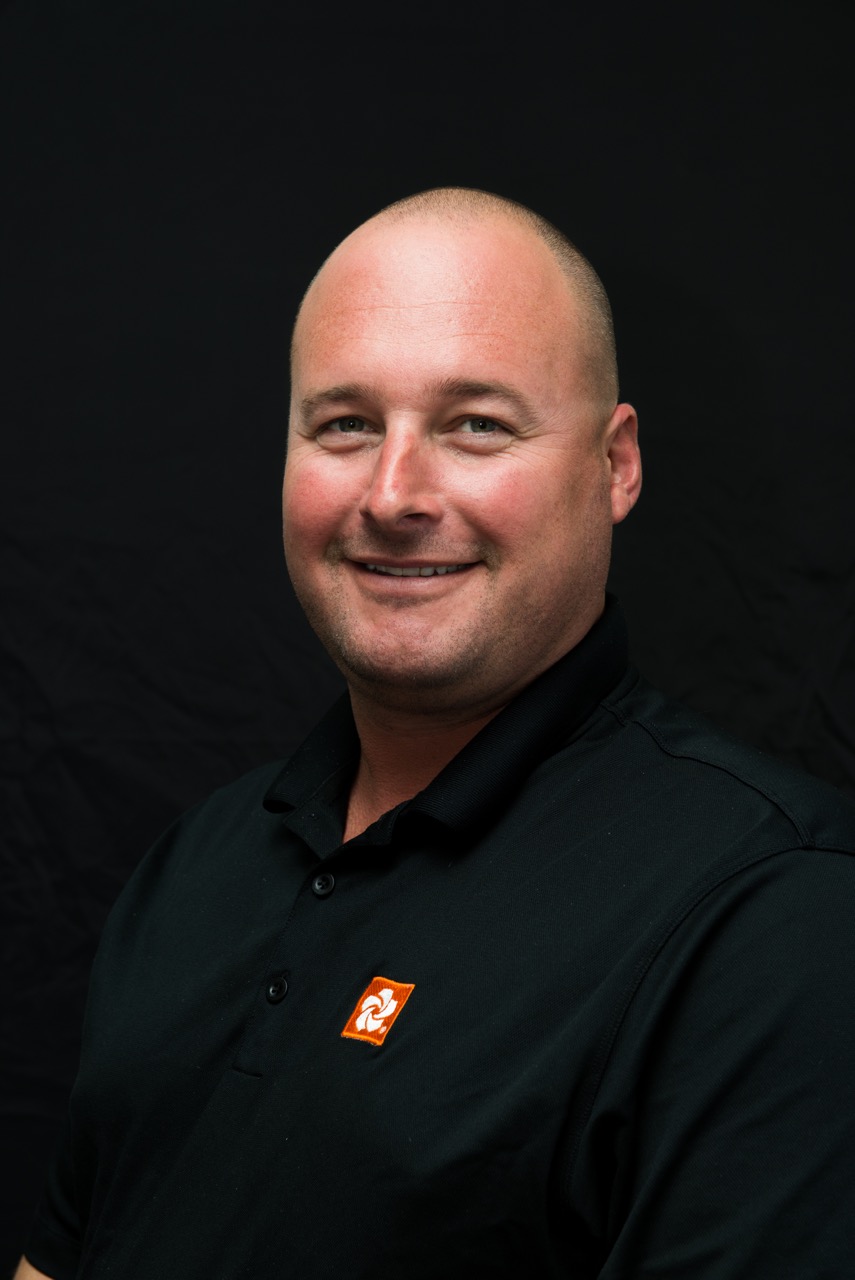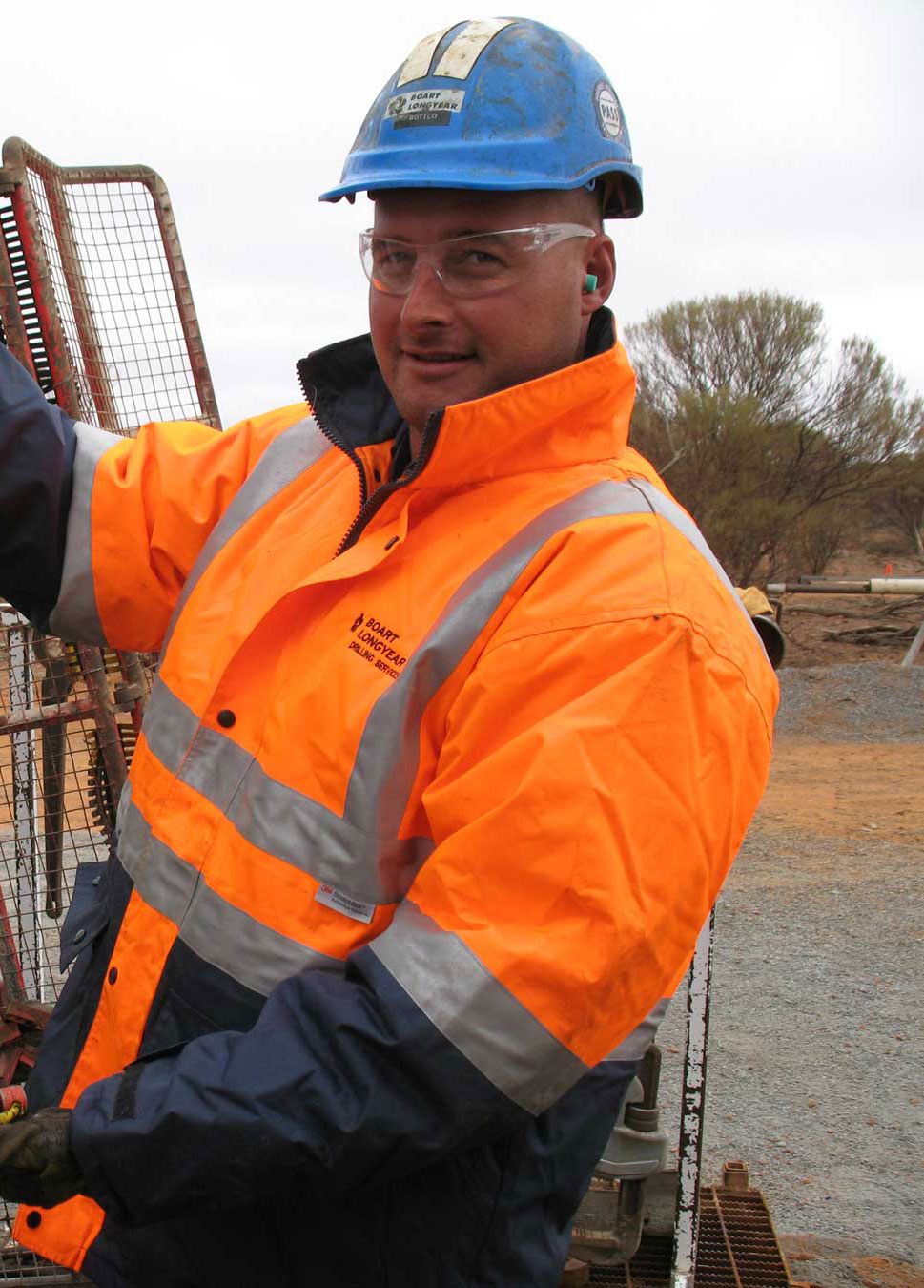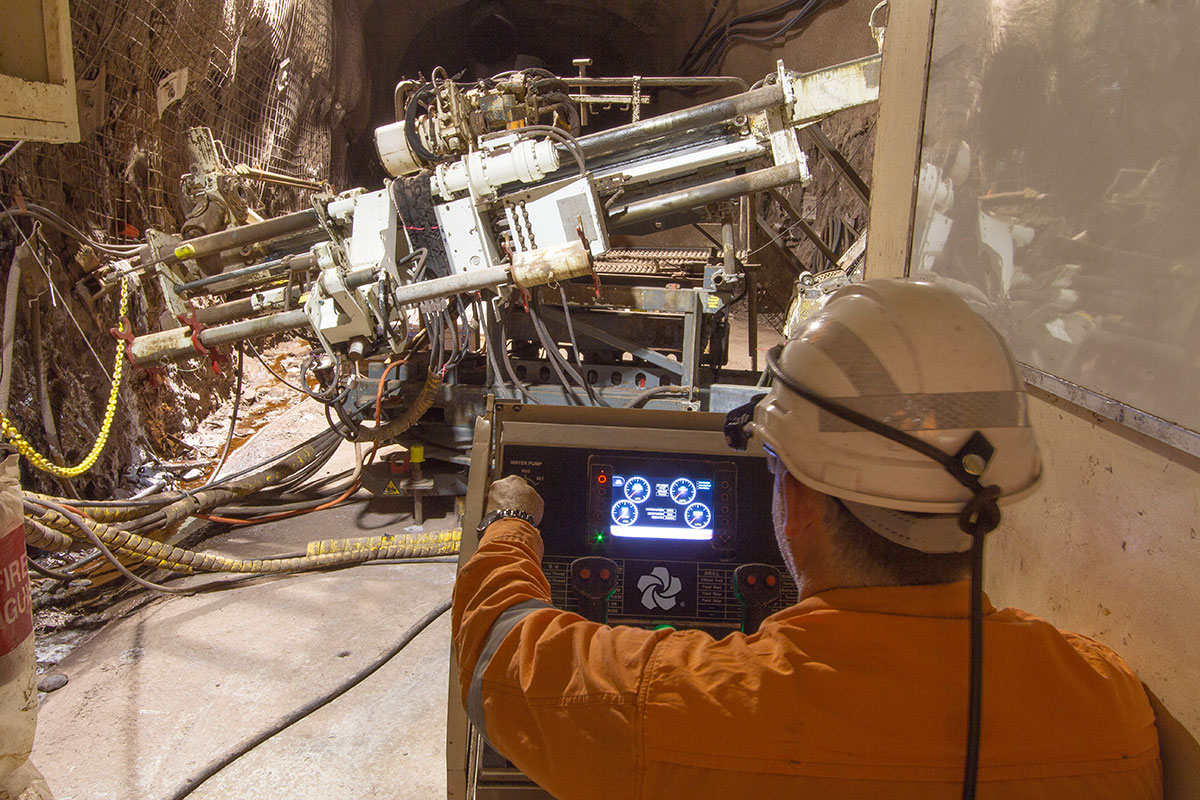EXPLORATION
juillet 21, 2020
Coring Magazine's exclusive interview with Chris Hopkins, Underground Operations, Boart Longyear Australia
This article was originally published in Coring Magazine, Issue 13, 2020.
21 Questions
Chris ‘Hoppy’ Hopkins grew up on New South Wales’ south coast, and later in Sydney’s western suburbs, yet a relocation to Perth, Western Australia at age 11 proved the ideal change of scenery. If in search of Chris, you’ll find him in one of three places – underground, in the great outdoors, enjoying time fishing, or in the kitchen, cooking his catch of the day.
In 2004, Chris started as a driller’s assistant with Drillcorp at Sunrise Dam, drilling initial diamond coring holes at Tropicana mine when it was still an exploration site, before moving onto deep directional drilling programs at Leonora and Forrestania. In 2006, Chris joined Boart Longyear (BLY) initially as a driller, before moving into a supervisory role at BHP Billiton’s Leinster and Mt Keith operations. This was when Chris developed a thorough appreciation of industry safety, and he’s grateful for the front row seat during a notable period of change in safety systems and workplace cultural maturity. In 2014, the Great Financial Crisis adversely impacted Australia’s mining and exploration with widespread reduction across all surface drilling. Chris was redirected to BLY’s Waterwell division across multiple Pilbara sites. Chris eventually returned to the Goldfields to assume a regional supervisor role before being rewarded with his current role as operations manager for BLY’s underground division, APAC.

Grigor Topev: How and why did you choose to pursue a career in drilling?
Chris Hopkins: My father worked within Chevron’s lubrications business, collecting many small-scale models of heavy mining equipment. As a kid, I was fascinated by his ‘toys’ – sparking my interest and a subsequent stream of questions to my patient, receptive Dad who has since retired. I greatly admire my Dad for his genuine want to be of value to his community and local church. At age 24, I became a father for the first time while working in the liquor industry and wanted to veer to an industry where hard work, commitment and dedication were appreciated. I was also itching for adventure and a change in scenery, having been inside a lively wine store for too long. The prospect of working in the great outdoors at remote locations, being physical, and solving mechanical issues really appealed, so I made the switch.
GT: Who is your inspiration within the drilling industry?
CH: My professional role models and mentors include the esteemed and respected likes of Dale Barron, Des Forde, Gregor Stephenson, the late John Emerson, and Murray Hillier. Their collective drilling knowledge, willingness to engage and educate, while offering support has had the most profound effect on my career.
GT: You’ve worked for Boart Longyear (BLY) for over 15 years, specializing and managing their Australian underground drilling operations – an impressive 35 rigs at any one time! What’s your most memorable experience with BLY so far?
CH: I can’t recall a specific moment or project, as I’ve enjoyed many adventures during my career. Drilling challenges me on so many levels – from working and living away in remote locations and interesting environments, to geological undertakings through difficult formations, and the eventual satisfaction of completing a deep directional drilling program. In true A-type style, I beam with unwavering pride when my rig, fleet and team present well and drill effectively.
Drilling challenges me on so many levels – from working and living away in remote locations and interesting environments, to geological undertakings through difficult formations, and the eventual satisfaction of completing a deep directional drilling program.
GT: List the three most important factors for successful underground operations.
CH: 1. Good work habits and a positive mental attitude: the underground space is a very physical and challenging workplace, but it’s also a great place to work – I love it! Every task has an exacting set of measures which must be followed, as short cuts are not tolerated. Determination and attention to detail is necessary given the restricted work areas, equipment limitations and specific underground drilling requirements that can vary from +90 to -90 degrees. Excellent communication is paramount as daily interaction with mining teams is necessary to deliver quality samples within specific time frames. It is quite common for a mining team to immediately assume an area once drilling is complete.
2. Safety culture maturity: we must respect and understand our working environment, and maturity toward safety is a prerequisite to the underground mining sphere, given the inherent risk in what we do. I cannot and will not tolerate immaturity or lack of focus as either will result in someone being hurt and equipment being damaged.
3. People: are the most important and defining facet to success – in any industry. People who genuinely care and take pride in their work and accomplishments are who you want on your team. I’ve been fortunate to have worked with talented and capable people, and I’m most proud of my current team – they are enthusiastic, professional, highly motivated and experienced. We’ve developed an amazing and supportive working culture as a result.
GT: Which is more challenging – underground or surface drilling?
CH: My somewhat cheeky response is whatever drilling type I’m currently focused on and involved in. Seriously, every discipline – underground or surface drilling has its own challenges including ground conditions, technical drilling requirements to achieve targets, underground grade control programs requiring multiple rig locations and set-ups per shift, to large diameter holes requiring large tooling to complete. The challenge of individual hole completion is what deems the drilling industry such an exciting business to work in. Up-hole drilling is a constant challenge, as underground geology departments strive to keep costs down. Sometimes the only way or location to achieve target is to drill ‘up’. Boart Longyear’s Roller Latch™ system allows crews to successfully and safely do so while following best drilling practices.

GT: How does safety differ from underground to surface drilling operations?
CH: Underground mining and drilling teams work closely, attending the same pre-start meetings and engaging more frequently than would occur at surface. When underground, everyone is under the supervision of the shift boss and underground mine manager, with increased engagement with the mining safety team. My drilling team has forged greater cohesion between the two groups, implementing exemplary practice and innovation that has been adopted by all, and I couldn’t be prouder.
GT: Can you explain why mining companies tend to subcontract third parties for surface drilling yet undertake underground drilling themselves?
CH: There are two reasons – risk and cost. Drilling is dangerous especially when poorly managed, so it makes sense to hire a professional contractor to complete the work. Contractors must be accountable and continually improve to secure future work. A lot of effort goes into delivering safe, seemingly hassle-free (for the client) drilling. Then there is cost. Most mining companies are incapable of cost-effective and productive in-house drilling. Contractors remain focused on achieving safe and productive outcomes for their ongoing financial survival and reputation.
Contractors must be accountable and continually improve to secure future work.
GT: Given your experience and current role managing BLY’s APAC Region underground operations, what has, or continues to be, the most challenging underground drilling issue you’ve had to resolve, and how did you do so?
CH: Delays associated with mine blasting and other mining activities significantly reduce the amount of time drilling crews must complete work, while eliciting an added expense to the client. BLY’s Drill Control Interface (DCi) system enables continuous drilling, even while the rig is unattended. Semi-autonomous capability within the underground drilling space is subject to an anticipated transformation, and it’s an exciting time. Many mines have, and continue to install underground Wi-Fi communication systems for enhanced communication between the drill crew and surface-based support crew.

GT: Let’s talk drilling innovation. Is there any singular piece of equipment, fluid/mud, rig, or tool that you regard as a ‘game-changer’? If so, why?
CH: The underground space is in need of innovation, and Boart Longyear’s dynamic approach has meant that I’ve been involved in the development and release of some of the industry’s leading improvements including Roller Latch™, diamond coring bits – designed and tested in the field by our drillers, and safety improvements to both drilling equipment and in the field training systems. Our fleet features machines that enhance the driller interface with improved safety and increased performance thanks to BLY’s ability to design and manufacture reliable rigs and drilling equipment, backed by adept and supportive maintenance teams, and an extensive global supply chain. I’m particularly excited about current innovations and advancements we expect to release within the next year. I can’t elaborate just yet, so watch this space.
GT: Do Australian underground drilling projects tend to use one drill hole size over another? If so, what is it and why?
CH: Most Australian underground drilling is N-size as it yields clients respectable sized core samples for the cost. For drilling contractors, N-size improves productivity with wireline systems, reduces manual handling when compared to conventional systems, and improves hole completion in poor formations. Boart Longyear’s Roller Latch™ system also provides much safer operations when drilling up holes, veering away from conventional processes.
GT: Now for tech talk. How do you approach a hole with high-pressure outflow?
CH: The potential to intercept an underground water source when drilling underground is both great, and undesirable. Thorough planning, detailed risk assessment and experience round out the high-pressure prevention trifecta, coupled with having the necessary tooling at the ready – should it be required.
GT: What measures do you apply to improve hole stability and caving formations?
CH: Drilling fluids are critical to hole completion in broken, unstable or pressurized formations – supporting all aspects of hole conditioning from reducing torque, assisting in the removal of cuttings, increasing hydrostatic pressure, stopping hydro sensitive formations from reacting, and some products hold together loose formations. Cost is critical and all staff – not just drilling crews must be educated as to correct usage to ensure zero to minimal wastage as this can greatly affect cost per meter. Reliable terminal equipment is key to ensure the most time down the hole. I’ve encountered many holes where formation stability is greatly reduced due to tripping of rods or introducing unnecessary pressures onto the formation, leading to extensive hole cleaning which then increases the likelihood of an unsuccessful hole completion.
GT: Do you utilize wedging in underground conditions, and what is your response to those who choose not to use it due to safety concerns?
CH: Boart Longyear makes use of wedging in both surface and underground operations. Wedging needn’t be a safety concern if effective planning and good communication are upheld. Importantly, we work closely with our clients to ensure this is the best option for them, as the cost to drill a new hole within the underground space can be cheaper than attempting directional drilling.
GT: Cement plugs tend to fail when diamond drilling. How do you apply them to prevent failure, or what do you use as an alternative?
CH: Cementing works best when it is kept simple, checking everything twice. Like the carpentry adage, ‘measure twice; cut once.’ Training is key – as it is with all aspects of drilling. Be mindful of setting and correctly calculating grout volume. Other points to note: is the cement type correct or best suited to the formation? Is the product within its best before date, and has it been stored correctly? Are the slurry volume calculations correct? Is the potential for contamination being limited while mixing and displacing slurry? Be sure to extract a slurry sample to reference. Importantly, if you’re using an additive, be sure to follow the manufacturer guidelines as more is not always better. Lastly, don’t feel pressured when attempting as this is when most mistakes do occur. In Australia, we use VAN RUTH® cementing plugs as they’re a proven product that work well.
GT: What is the most common driller-induced issue that occurs at rigs, and what can be done to prevent it?
CH: Lack of preparation. A driller’s day starts with the all-important pre-start meeting, where supervisors outline and ensure that their teams understand what is expected to occur during that shift. Appropriate and reliable equipment is made available for the crew to safely complete every task and activity. Rushing to complete a job, particularly due to failure to plan, or lack of preparation is a recipe for disaster – namely injury.
GT: Tell us more about the deep directional drilling project you are part of?
CH: I’ve been fortunate to have been involved in many deep directional drilling programs throughout Western Australia, however, it’s important to note that this drilling method varies from production-based drilling within the underground space. The focus is on hole completion and hitting the desired target. It’s complex, extremely technical, and requires intensive supervision, as every decision affects how the hole is drilled from start to finish. I enjoy drilling at depth – the planning, preparation, and necessary attention to detail (correct choice and use of equipment, barrel configurations and monitoring the hole’s deviation) to achieve target. It’s a proud moment to be part of a team that successfully reaches end of hole, delivering a sample of an ore body to a client from over 2000-meters depth.
GT: Mud motor (navi) drilling seems popular in Australia. Do you agree and how prevalent has it become at drill sites?
CH: Directional drilling using down hole motors is an effective method to hit multiple targets from a ‘parent’ hole. The method is best applied to deeper targets and areas where the cost to drill through waste rock exceeds the cost to complete the directional requirements to reach the targeted zone.
GT: What about gyro survey tools? Are you an avid user and advocate? Why?
CH: The survey industry and its products are rapidly advancing in capability and reliability, with fantastic products available. Most importantly, the system must meet client requirements and be easy to operate, with flexibility for drilling teams to utilize tools to maintain effectiveness. I’m a firm advocate of the Azimuth Aligner® as it reduces rig set up time and relieves pressure on mine survey teams.
GT: How has COVID-19 affected Australia’s underground operations?
CH: Mining is critical to Australia’s economy, and every operation has been closely monitored to eliminate or minimize risk. Australia truly is the ‘lucky country’ for a few reasons – our geographic isolation and relatively small population combined with our swift acting government’s measures (international and state border lockdowns and mandatory 14-day self-isolation), has so far protected us as a nation. Over 25 million people live in Australia, yet our death rate from the pandemic is deemed low – just over 100 people. We must never be complacent and we’re mindful of the much talked about second and third phases, hence Australia’s strict border controls.
GT: What’s diamond drilling’s future from a technical/innovation perspective?
CH: Exciting technologies are being harnessed and adapted within diamond drilling. Many contractors are relentless in their pursuit to remove manual handling for a twofold result – eliminate and minimize injuries, while encouraging the broader community to consider the profession. Drilling cannot occur without people and the industry benefits when dedicated, focused and diligent people continually strive to improve perception and conditions. People are the future of drilling, so we must ensure that our industry evolves with safety, education, innovative systems and solutions at its forefront, as evidenced by key groups such as Australian Drilling Industry Association (ADIA) – endeavoring to improve standards and protocol for collective success – now and in the future. I’m currently involved at a research and development level, applying expert advice and feedback to hone various soon-to-be-released Boart Longyear equipment and tools that will greatly improve safety and productivity, while questioning how we approach drilling. It’s an incredibly exciting time to be in the industry and I personally cannot wait to see it come to fruition. Watch this space!
SIGN UP FOR THE INSITE DIGEST
Sign up for the INSITE Digest to receive articles like this and more.
SIGN UP NOW
DISCUSSION
-
На этом сайте вы сможете найти полезную информацию о препарате Ципралекс. Вы узнаете здесь информация о показаниях, режиме приёма и вероятных побочных эффектах. http://QarahKeselkhehIran.auio.xyz/category/website/wgI2vZFhZf5rbhFqBTP7G0CD1
-
Программа видеонаблюдения – это актуальное решение для защиты имущества, сочетающий инновации и простоту управления. На веб-ресурсе вы найдете подробное руководство по настройке и установке систем видеонаблюдения, включая облачные решения , их сильные и слабые стороны. Программы для видеонаблюдения Рассматриваются гибридные модели , объединяющие локальное и удаленное хранение, что делает систему универсальной и эффективной. Важной частью является разбор ключевых интеллектуальных возможностей, таких как детекция движения , идентификация элементов и дополнительные алгоритмы искусственного интеллекта.




